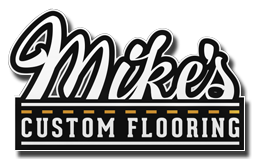Water damage on hardwood floors can be a homeowner’s nightmare, leading to warping, discoloration, and even mold growth if not addressed promptly and effectively. Whether it is from a flood, leaky roof, or a simple spill that was not cleaned up quickly, the integrity of your hardwood floors can be compromised. However, with the right approach, restoring your floors to their former glory is entirely possible. Mikes Custom Flooring will share how to tackle water damage on hardwood floors.
Assess the Damage
The first step in any restoration process is to assess the extent of the damage. This involves determining how much of the floor has been affected and the severity of the damage. Light damage might only require drying and refinishing, while more severe cases could necessitate the replacement of planks. It’s important to identify signs of mold or mildew, as these can pose health risks and complicate the restoration process.
Remove Standing Water
If there is any standing water on the floor, it is essential to remove it immediately. Use towels, mops, or a wet vacuum to dry the area thoroughly. The longer the water sits, the deeper it will penetrate into the wood, exacerbating the damage and making the restoration process more challenging.
Dry Out the Area
After removing standing water, the next step is to dry out the affected area completely. This can be achieved by using dehumidifiers, fans, or air movers to circulate air and remove moisture. It is important to maintain a consistent airflow over the damaged area for several days or even weeks, depending on the severity of the water damage. Avoid using excessive heat, as this can cause the wood to warp further.
Sand & Refinish Hardwood Flooring
Once the floor is thoroughly dried, inspect the wood for warping or cupping. If the planks have only minor warping, sanding might be enough to restore them. Start with a coarse-grit sandpaper and gradually move to finer grits until the floor is smooth. After sanding, apply a new finish to protect the wood and restore its aesthetic appeal. Choose a finish that matches the original as closely as possible or take this opportunity to update the look of your floors with a new stain or sealant.
Replace Damaged Hardwood Planks
In cases where the water damage is too extensive for sanding and refinishing to be effective, replacing damaged planks may be necessary. This involves carefully removing the affected planks and replacing them with new ones. It is essential to match the new wood as closely as possible to the existing floor in terms of species, thickness, and finish. Professional help may be required to ensure a seamless restoration.
Prevent Future Hardwood Floor Damage
Finally, take preventive measures to protect your hardwood floors from future water damage. This can include ensuring proper home maintenance, such as fixing leaks promptly, installing water sensors, and maintaining optimal indoor humidity levels. Area rugs and mats can also provide additional protection in high-risk areas.
Hardwood Floor Installation, Repairs, Refinishing & More in Charles Town & Eastern Panhandle of Berkeley & Jefferson Counties in WV | Winchester & Frederick County | Round Hill & Loudoun County | Berryville & Clarke County | Herndon & Fairfax County VA
Restoring water-damaged hardwood floors is a painstaking process that requires patience and attention to detail. However, by following these steps, it is possible to salvage your floors and avoid the cost and inconvenience of a complete replacement. The key to successful restoration is acting quickly and methodically to remove water, dry the area, and repair the damage. If the task needs professional assistance, contact Mike’s Custom Flooring and schedule our services today.





